Hockey Stick Blade Curve & Pattern Chart: Which Lie is Right for You?
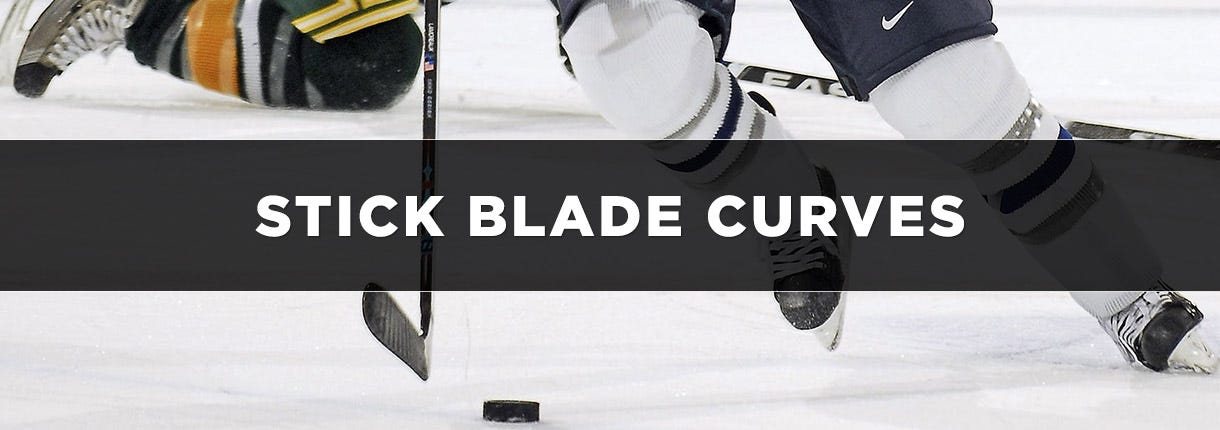
When buying a new Ice Hockey Stick there are several different factors you might take into consideration. For example, length, weight, and flex, but perhaps the most important quality of an Ice Hockey Stick will be the Hockey Stick Curve or Hockey Stick Pattern. Most major Hockey Stick brands have a variety of different Hockey Stick Curves, with many of them having both strengths and weaknesses. When determining which Hockey Stick Curve would be best for you, it is important to keep in mind what position you play, what type of shots you primarily take, and which one plays the best to the strengths of your game.
That said, this guide will dive into what some of the different types of curves, how they affect the puck, Hockey Stick Curves from the major stick brands, some NHL player curves, along with some popular commonly asked questions about Hockey Stick Blade Curves.
- What Influences Hockey Blade Curve?
- How Does Blade Curve Affect Puck Control?
- Hockey Stick Blade Curve Chart
- NHL Player Curves
- Hockey Stick Blade Curve Patterns by Brand
- Common Questions About Hockey Stick Blade Curves
What Influences Hockey Blade Curve?
- Heel Curves are blades that have more of a curve near the base (or Heel) of the blade. This means that the curve of the blade will start here with the middle and toe of the blade straightening out a little bit. Heel Curves are predominantly used by defensemen as they help improve slap shot power and accuracy.
- On the contrary, Toe Curves are blades that have most of their curve at the toe area of the blade. Hockey Stick Patterns that are listed as having Toe Curves are often preferred by forwards as they will allow them to lift the puck quicker and easier during shooting in tight spaces.
- Mid Curves are a balance of the two. Due to most of the curve being in the middle of the blade, Hockey Sticks with these Blade Patterns are great for stickhandlers, passers, and accuracy on all types of shots, including backhand shots.
- All Hockey Stick Curves have some degree of loft to them. This is similar to how golf wedges look, but to a much lesser extent. Hockey Stick Blades with a closed face will help keep shots low and powerful, with more straight-line velocity. Slightly open faces are slightly more open than the closed option, so it will still provide great power on heavy shots, while also give players an easier time lifting the puck on shots. Open faced blade types are, as the name states, the most open of the three. Blade Patterns with open faces are great for getting the puck up in the air as quickly as possible in tight areas.
- Hockey Blade Curve Depth refers to how deep the actual curve of the blade is. There are three primary curve depths regarding Hockey Stick Curves; Moderate curves, slight curves, and deep curves, and usually range from 3/8th” to ½”. For perspective, a perfectly flat blade has a zero depth. A slight curve depth provides great accuracy on all shot types and puck control but will be harder to lift the puck. A moderate curve depth (1/2”) is the most popular and will help improve puck control, improve the ability to lift the puck easier (compared to slight), all while still having a good backhand. A deep curve depth will provide the most control thanks to the blade being able to really cup the puck. This option will also help snipe corners in tight spaces. However, backhand shots will be much harder to utilize. Hockey Blade Patterns with deep curve depths are not recommended for beginners.
- The Lie of a Hockey Stick refers to the angle that your stick is at when the bottom of your blade is flat on the ice. If you stand on the ice holding the stick to your side normally, and the blade is more on its heel or toe, then you have the wrong Hockey Stick Lie. You want the blade to lie flat (have the right lie) as it will help control the puck while stickhandling, receiving passes, and shooting. The most common Hockey Stick Lies are 4,5, and 6. A four Lie is great for players who skate with a lower center of balance, with the puck out in front of them more often. A higher lie, like six, will cater towards players who skate more upright, with the puck closer to their body. This will be the preferred lie for quick, puck handling forwards. A lie five is a good balance between the two.
How Does Blade Curve Affect Puck Control?
- Puck Spin - The Curve of an Ice Hockey Stick Blade helps generate spin on your shots and passes. Like a football, the spinning motion of a Hockey Puck increases stability and accuracy.
- Control - The Curve of an Ice Hockey Stick Blade greatly increases puck control during stickhandling, especially quick stick handling in tight spaces. It makes it easier to “grab” the puck with your blade without it rolling off.
- Shot Power - The Curve of an Ice Hockey Stick also helps increase shot power. Due to you being able to cup the puck with the curve, paired with the spin added, it will help increase shot speed.
Hockey Stick Blade Curve Chart
| Hockey Stick Blade Chart | ||||
|---|---|---|---|---|
| Picture | Description | Brand Examples | Specs | |
 | Great starter pattern and still one of the most popular patterns in the game today. Provides great puck control, quick releases, great ontrol on shots. | Bauer: P92 CCM: P29 Warrior: P03 True: TC2 | Curve: Mid Size: Big Face: Open Lie: 5-6 Toe: Round | |
 | Fastest growing pattern in hockey. Great for toe drags, quick releases, and getting lift on your shots. | Bauer: P28 CCM: P28 Warrior: W28 True: TC4 | Curve: Mid/Toe Size: Big Face: Open Lie: 5-6 Toe: Round | |
 | Classic mid-curve blade. Great all-around blade for stick-handling, wrist shots, and and quick releases. Also good for backhand shots. | Bauer: P88 CCM: P88 Warrior: P88 True: MC | Curve: Mid Size: Medium Face: Slight Open Lie: 4-5 Toe: Round | |
 | Great mid-curve option for players who take a wide variety of shots. Backhands, quick snap shots, and wrist shots. Also great for stickhandling in tight spaces. | Bauer: PM9 CCM: P14/P15 Warrior: W01 True: MC2 | Curve: Mid-Heel Size: Small Face: Closed Lie: 5 Toe: Round | |
NHL Player Curves
Ovechkin Curve (P88)
The Ovechkin Curve (formerly Bauer’s popular P92 curve) is now a P88 curve. This classic mid-curve blade is a great all-around blade, excelling in puck control, stick handling, hard wrist shots, and quick releases!
Stamkos Curve (PM9)
The Bauer PM9 features a Mid-Heel Curve with a closed face. This rather tame Hockey Stick Curve is a great option for stickhandling and taking both forehand and backhand shots.
Crosby Curve (P29)
Sidney Crosby uses a CCM P29 curve. This Hockey Stick Blade is one of the most popular in the game today and features a deep mid-curve allowing for great stickhandling and puck control. However, it also utilizes a very open face that provide maximum lift on your shots. As a downside of the very open face, backhand shooting and passing accuracy will be negatively affected.
McDavid Curve (P28)
Perhaps the fastest growing Hockey Blade right now is the P28 “McDavid” curve. This Hockey Blade curve is a great option for players who play the game with the puck on the toe of their stick, due to the toe curve with an open face. This makes it very easy for players to get the puck off their blade and into the top corner quickly. However, while this curve is a great shooters curve, it is one of the hardest to learn and control due to the amount of lift it creates.
Hockey Stick Blade Curve Patterns by Brand
Bauer Curve and Blade Pattern Chart
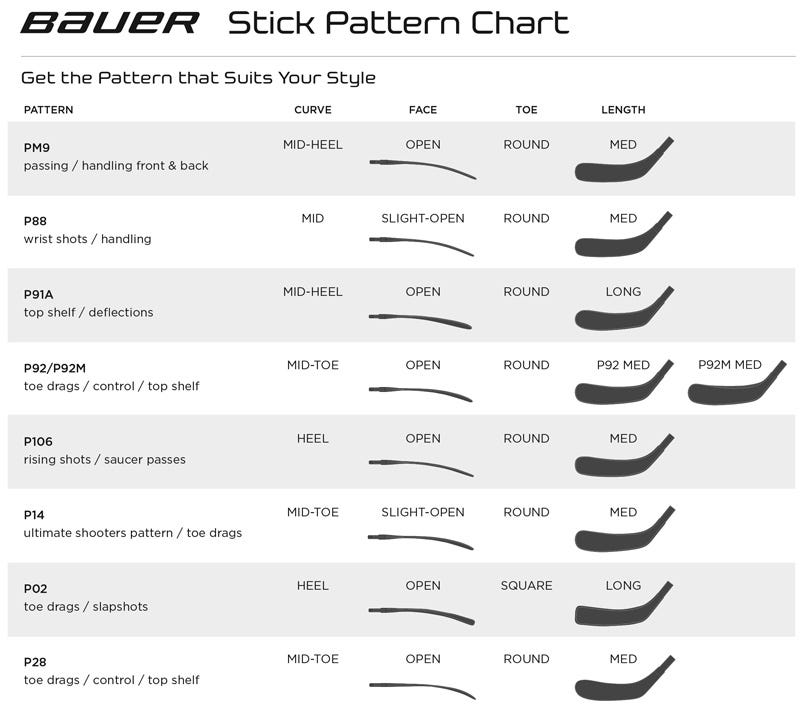
CCM Curve and Blade Pattern Chart
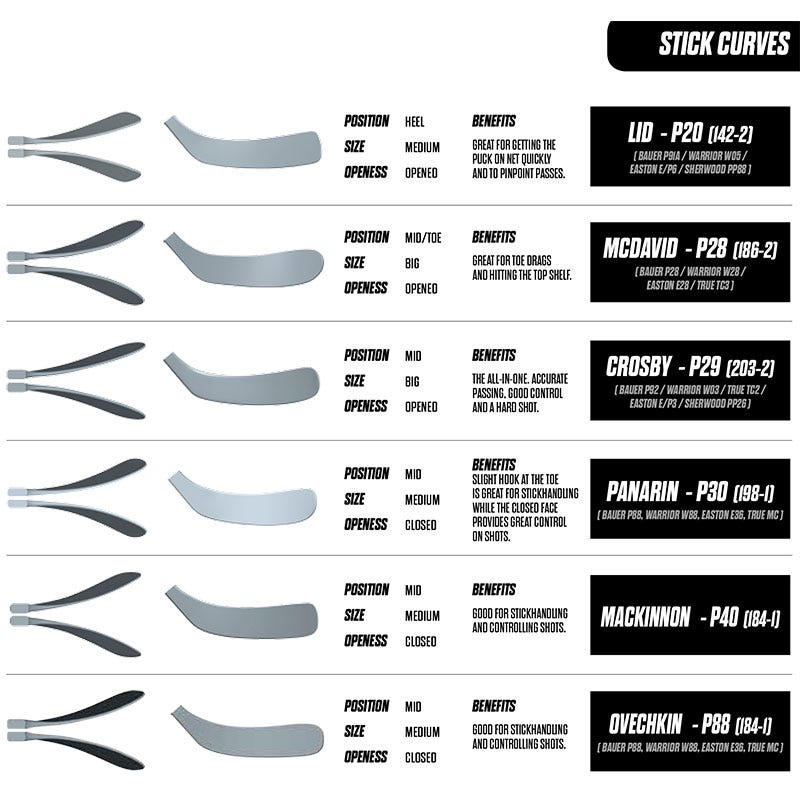
Warrior Curve and Blade Pattern Chart
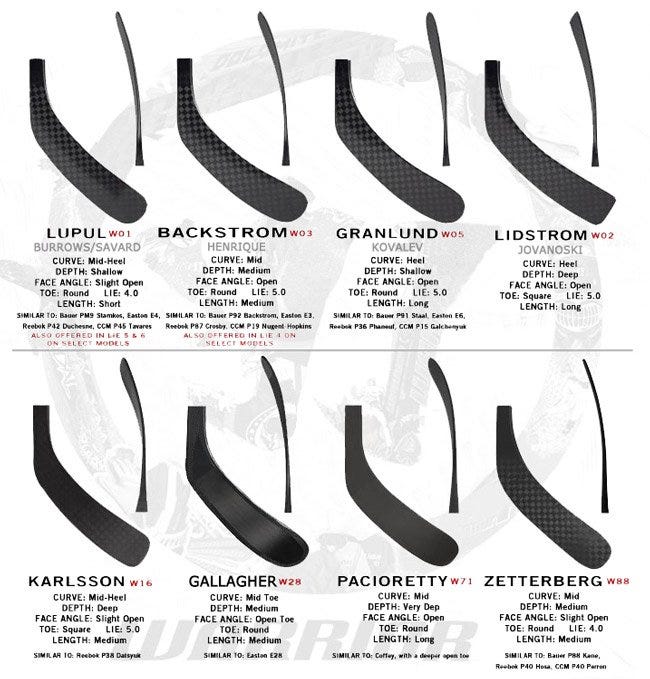
True Curve and Blade Pattern Chart
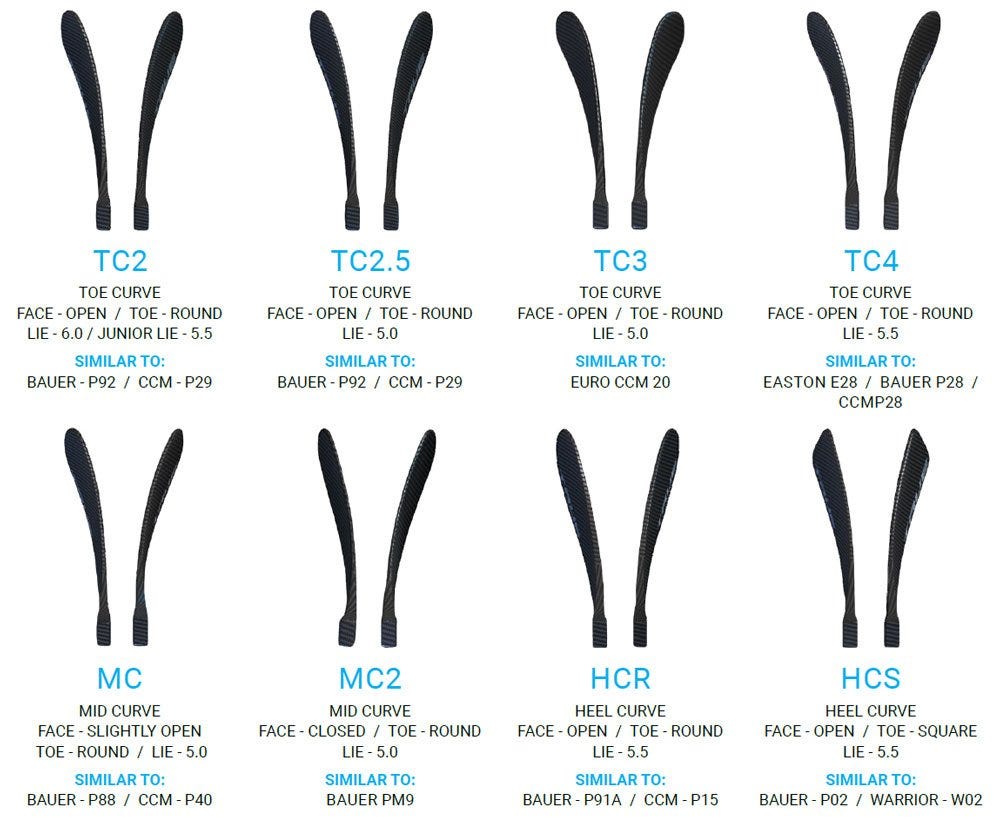
Sher-Wood Curve and Blade Pattern Chart
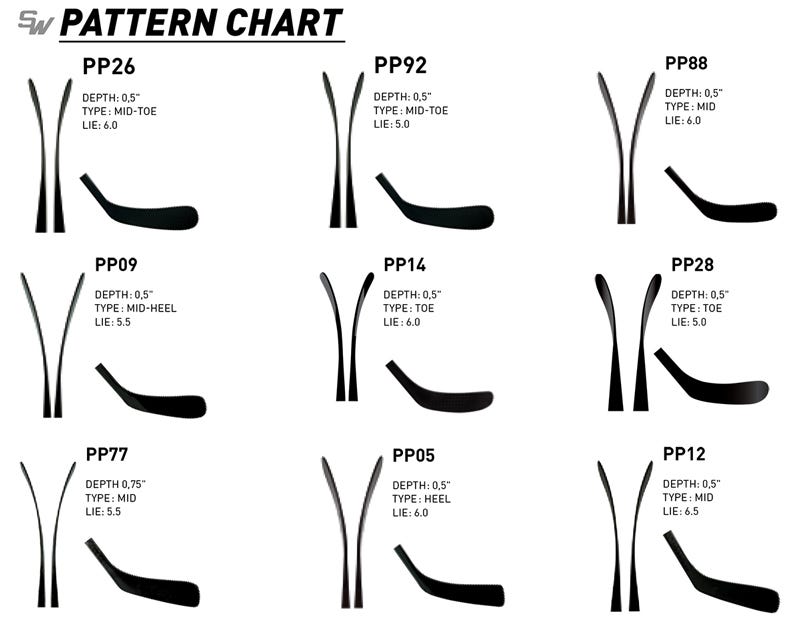
Easton Curve and Blade Pattern Chart
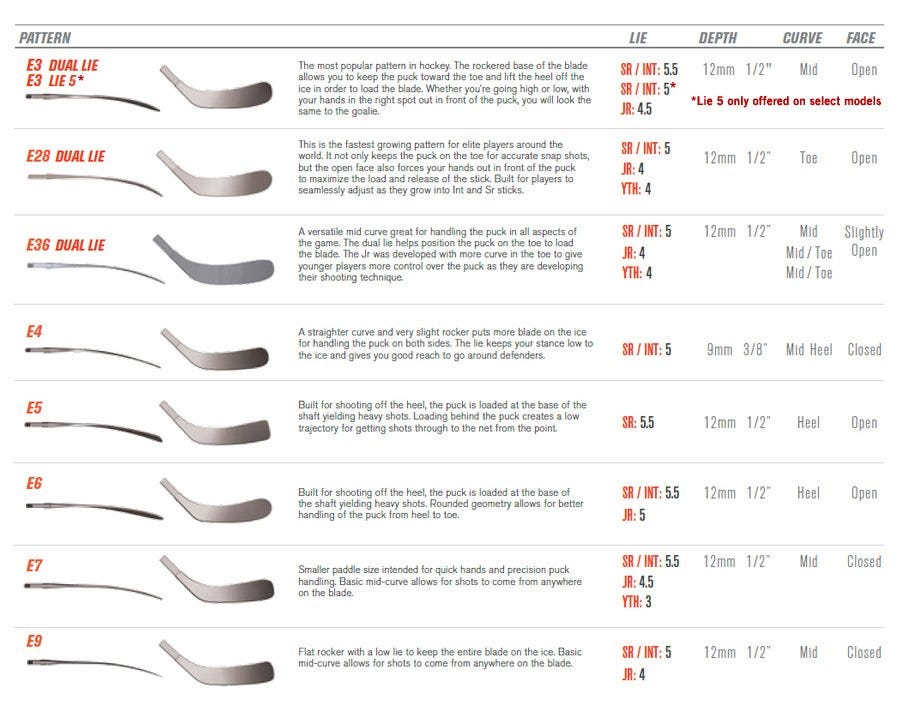
Choose the Right Blade Pattern with HockeyMonkey!
There can be a lot to learn when it comes to Hockey Stick Curves, so stop in to any one of our MonkeySports stores across the United States, where you can try out various curves in the shooting rooms! In the meantime, you can learn additional information about our different Hockey Stick Blades by visiting our website here!
Common Questions About Hockey Stick Blade Curves
Is there an illegal curve type?
There are no retail curves currently made that would be deemed illegal. A way to check if a curve is illegal is to lay the stick flat so that the curve of the blade is flat against a surface. Stand a quarter up and see if it fits inside the curve of the blade. If it does, it means that Hockey Blade Pattern has too much curve and is illegal.
How long does a hockey stick blade last?
There are a few different factors when determining how long a hockey stick blade lasts. The two biggest factors are playing frequency, and the level of play at which you are playing at. If you are playing at a highly-competitive youth or collegiate level, where you are on the ice every single day, there is a higher chance of your stick blade developing “stress fractures” in the toe and heel areas. This could be due to more stick checks from opposing players, more puck battles along the boards, and so on. This is a big reason why players at this level will have numerous backup sticks.
On the contrary, if you are a player playing in a recreational league one or two times a week, your stick could last you a few full seasons!
Other factors to consider would be the position you play, stick construction, and ice quality.
To help alleviate some potential damage to your blade, consider taping the entirety of the blade, rather than leaving the heel or toe exposed!



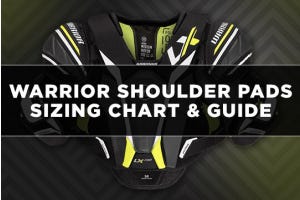
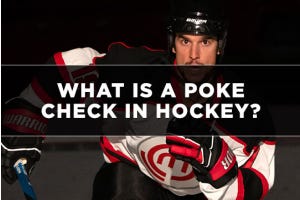




Login and Registration Form
or
Create an account